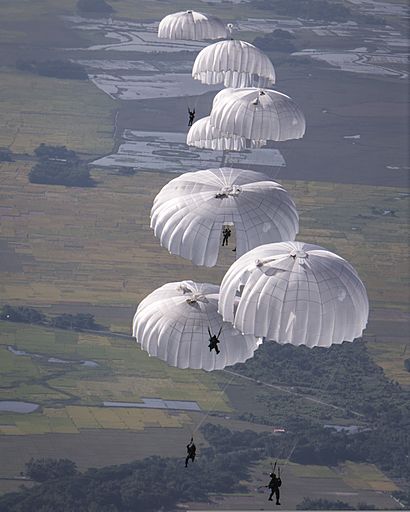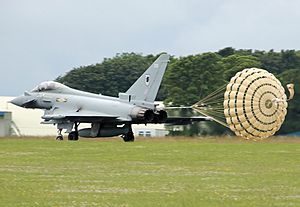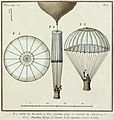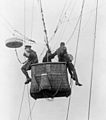Parachute facts for kids
A parachute is a special device that helps slow down an object as it falls through the air. It works by creating a lot of air resistance, which is like the air pushing back against the object. Some parachutes, called ram-air parachutes, also create lift, helping them glide.
Parachutes are mostly used to help people, like skydivers or pilots, safely jump from aircraft high in the sky and land gently on the ground. They are also used to drop things like food, equipment, space capsules, and even bombs.
Most parachutes are made from a light but very strong fabric, often nylon. Long ago, they were made of silk. While many parachutes look like a dome or umbrella, some are shaped like rectangles or even inverted domes.
Contents
The Amazing History of Parachutes
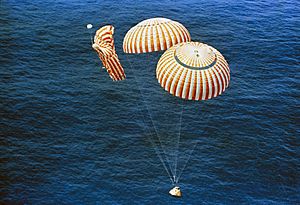
The idea of slowing a fall with a big piece of fabric is very old! Even the famous inventor Leonardo da Vinci (who lived from 1452 to 1519) drew pictures of parachute designs. He imagined a pyramid-shaped parachute made of linen, a strong cloth. But his ideas weren't actually tested until much later.
First Jumps and Big Steps
In 1783, a French scientist named Louis-Sébastien Lenormand made the first successful parachute jump. He used an umbrella-shaped parachute made of linen and jumped from a tall building. This wasn't a super high jump, but it was a huge step forward! He even wrote a book about his experiment.
Then, in 1837, a French balloonist named André-Jacques Garnerin made history. He completed the first parachute jump from a hot air balloon. This was a much higher jump, proving that parachutes could be used to escape from balloons safely. He did many jumps to show how reliable his parachute was.
Parachutes in Modern Times
The 1900s brought big changes for parachutes. During World War I (1914-1918) and World War II (1939-1945), parachutes became super important. Soldiers needed a safe way to jump out of airplanes. This led to many improvements in parachute design, making them stronger, more reliable, and easier to use. Thousands of soldiers depended on parachutes to save their lives during these wars. The invention of nylon, a strong and light material, was a game-changer for making parachutes.
How Parachutes Work
Parachutes work because of something called air resistance. Imagine dropping a flat sheet of paper and a small rock at the same time. The rock falls much faster, right? That's because the paper has more air resistance. Air resistance is the force that air pushes against an object as it moves through it.
A parachute is designed to create a lot of air resistance. Its large surface area catches a lot of air, which slows down the fall. The bigger the parachute, the more air it catches, and the slower you descend. Think of it like a giant hand pushing against the air, slowing you down.
The shape of the parachute is also important. Most parachutes are round or square. The shape helps to spread the air resistance evenly, making the descent smooth and controlled.
Different Types of Parachutes
There are many kinds of parachutes, each made for a special job.
- Round Parachutes: These are the classic, umbrella-shaped parachutes. They are simple and dependable. They were very common in the past and are still used for some purposes today.
- Square Parachutes: These parachutes have a more rectangular shape. They are often used for dropping cargo, like supplies or equipment, because they can deliver them accurately.
- Ram-Air Parachutes: These are more modern parachutes. They have special vents that inflate them with air, allowing for more precise steering and control during the descent. Skydivers often use these for more controlled landings.
- Parafoils: These are wing-shaped parachutes that are very easy to steer. They are used in paragliding, a sport where people fly using these special wing-shaped parachutes.
- Emergency Parachutes: These are small, light parachutes designed for unexpected situations. They are often carried in airplanes and helicopters as a backup safety system.
Cool Parachute Facts and Figures
- Opening Time: A typical parachute takes about 2 to 3 seconds to fully open after it's released.
- Falling Speed: How fast a parachute falls depends on its size and shape. Usually, it's around 15 to 20 feet per second (which is about 10 to 13 miles per hour).
- Materials: Modern parachutes are made from strong, lightweight materials like nylon or ripstop nylon. Ripstop nylon has special reinforced threads to stop tears from spreading.
- Weight It Can Carry: The amount of weight a parachute can carry changes based on its size and design. Some can carry hundreds of pounds of cargo, while others are just for one person.
- Safety First: Many modern parachutes have a second, smaller reserve parachute. This is a backup in case the main parachute has a problem, adding an extra layer of safety.
- Training: People who use parachutes, like skydivers, get a lot of training. They learn how to pack the parachute, how to jump safely, and what to do in emergencies.
Amazing Parachute Records
On August 16, 1960, Joseph Kittinger made an incredible jump for the Excelsior III test. He set a world record for the highest parachute jump at the time. He jumped from a balloon at an amazing height of 102,800 feet (31,333 meters)! A small parachute helped stabilize him, and he fell for 4 minutes and 36 seconds. This is still a world record for the longest free-fall with a stabilizer chute. At 17,500 feet (5,334 meters), Kittinger opened his main parachute and landed safely in the New Mexico desert. His whole trip down took 13 minutes and 45 seconds. During his fall, it was super cold, as low as -94°F (-70°C). He reached a top speed of 614 mph (988 km/h), which is almost the speed of sound!
Later, on October 14, 2012, Felix Baumgartner broke Joseph Kittinger's record. He jumped from an even higher altitude of 127,852 feet (38,969.3 meters) as part of the Red Bull Stratos project. He reached speeds up to 833.9 mph (1,342.0 km/h), which was faster than the speed of sound! Joseph Kittinger was even an advisor for Baumgartner's jump.
Another record was set by Alan Eustace on October 24, 2014. He jumped from the stratosphere from an altitude of 135,889.108 feet (41,419 meters). However, Eustace used a small drogue parachute during his jump, while Baumgartner did not. This means their records are in different categories.
Images for kids
-
Louis-Sébastien Lenormand jumping from a tower in 1783.
-
The first use of a parachute without a frame, by André-Jacques Garnerin in 1797.
-
Gleb Kotelnikov and his invention, the knapsack parachute.
-
An American paratrooper using a "round" parachute.
-
The Mars Science Laboratory capsule, carrying the Mars rover Curiosity, falling with its supersonic parachute.
-
Paragliding in Canada, 1991.
-
Paragliding over the Christ the Redeemer statue in Brazil, 2015.
-
A United States Navy Parachute Team jumper landing a "square" ram-air parachute.
See also
 In Spanish: Paracaídas para niños
In Spanish: Paracaídas para niños
- Airdrop
- Ballistic parachute
- Cirrus Airframe Parachute System
- Extreme sport
- Free fall
- Parachute landing fall
- Parachuting
- Paragliding
- Ejection seat


